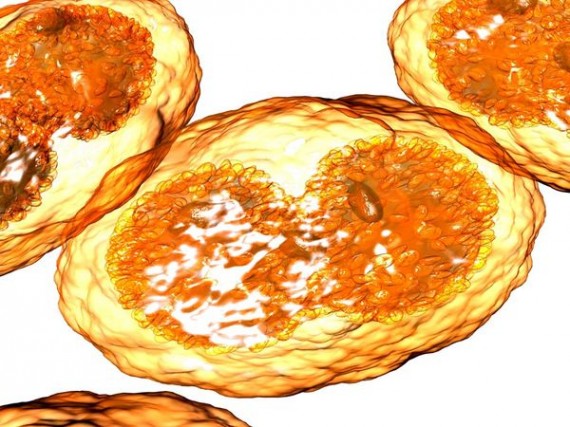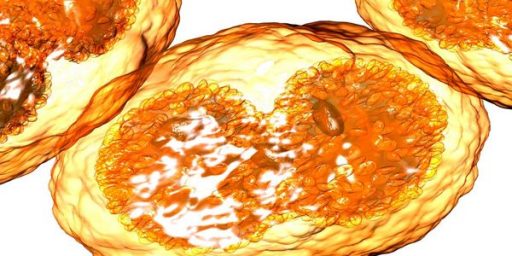Misplaced Vials Of Smallpox Found Abandoned In Storage Room
The Federal Government recently found vials containing the smallpox virus abandoned in an unsecured closet:
Six vials of potentially deadly smallpox virus have been discovered in a place they shouldn’t have been — an unused corner of a storage room at a Food and Drug Administration laboratory in Maryland, federal health officials said Tuesday.
It’s the second lab lapse discovered in a month at federal facilities, though this mistake actually happened decades ago, experts emphasized. In June, more than 80 employees at a Centers for Disease Control laboratory were exposed to airborne anthrax bacteria in an embarrassing blunder.
But the new situation is different. The vials labeled variola, commonly known as smallpox, were discovered July 1 on the campus of the National Institutes of Health in Bethesda, by surprised employees preparing for an upcoming move, according to the CDC. NIH staff immediately notified the CDC’s Divison of Select Agents and Toxins, or DSAT.
Tests confirmed the samples contained smallpox DNA. On Monday, they were safely transferred to the CDC’s high-containment laboratory in Atlanta.
The vials weren’t breached and biosafety personnel detected no risk of exposure to lab workers or the general public, CDC spokesman Tom Skinner said in a statement. Further tests that can take up to two weeks will determine whether the samples are viable, meaning they can grow in tissue culture, with the potential to spread.
The virus samples may have been in the storage unit since the laboratory was transferred from NIH to FDA in 1972, along with the responsibility for regulating biologic products. They appear to date from the 1950s, officials said.
Lab officials handled the situation appropriately, said Michael Osterholm, director of the Center for Infectious Disease Research and Policy at the University of Minnesota, who called the incident “a reminder to look at every freezer you have now just in case.”Still, the finding raises questions about why the vials were there at all, when international agreement stipulates that there are only two sites approved as repositories for smallpox samples: the CDC’s secure BSL-4 lab in Atlanta and the State Research Centre of Virology and Biotechnology (VECTOR) in Novosibirsk, Russia. The World Health Organization oversees these smallpox facilities and conducts regular reviews to certify safety and security.
Although it should be rather obvious, Brad Plumer explains why this is a big deal:
Lately, there’s been a fierce debate about whether the last two labs in the United States and Russia should destroy their official stockpiles of smallpox. The case for destruction — this disease is deadly and could escape. (Smallpox needs to be kept cold to stay alive, but it can usually remain deadly even after it’s frozen.) The case against destruction — maybe we need it for research.
But as my colleague Susannah Locke pointed out, there’s a third consideration. It’s entirely possible that the US and Russia won’t be able to destroy smallpox once and for all — if they’re not the only ones with the virus. Maybe there are still unaccounted-for samples out there, lurking in the storage closets of some lab. Alternatively, there’s the possibility that some rogue smallpox viruses still exist on dead bodies. (The CDC often takes security precautions whenever archaeologists chance upon an old mummy with a smallpox scab.)
It’s unclear whether the smallpox virus found in the Bethesda lab is alive or dead — there seems to be some disagreement as to whether it was kept in cold storage or at room temperature (the latter would likely kill the virus). In either case, the samples are being taken to CDC headquarters for testing and will then be destroyed.
I’ve written twice previously this year about the renewed debate about whether or not the last known samples of smallpox should be destroyed, here and here. As I noted then, a good part of the argument in favor of the argument to destroy the samples is that they are, in fact, the last known samples of the virus on the planet. If they aren’t, then it’s always possible that the virus, or a mutated form of it, could return and wreck havoc on public health before medical professionals are able to come up with effective countermeasures. By maintaining the samples, there would at least be the possibility of having something of a running start in the event that happened. Now that we have confirmation that even the CDC may not have a handle on all its smallpox samples, it seems to me as though the debate is over. Keep the samples we have alive. Better safe than sorry.
Update: The original version of this post indicated that the vials had been found at a Centers for Disease Control facility. As the first comment to this post notes, that wasn’t the case. I have update the post to reflect the correct information.






Actually, they were found in a storage room at National Institutes of Health in Bethesda, Maryland. Then moved to CDC in Atlanta via FBI escort.
You are correct. I’ve update the post.
I can think of no better argument that the vials of virus should be destroyed.
Destroy them. If somehow the dreaded disease appears somewhere, those infected individuals can be used to study the virus.
And we want to store and keep track of nuclear waste safely for ten thousand to one million years* in a way that it will be well marked and no future generation will stumble on it inadvertently or use it for nefarious purposes.
Not to say that it can not be done but it will be a formidable task.
*National Research Council (1995). Technical Bases for Yucca Mountain Standards. Washington, D.C.: National Academy Press. cited in “The Status of Nuclear Waste Disposal”. The American Physical Society. January 2006. Retrieved 2008-06-06.
The virus has been sequenced. Actually, several variations as well. Toss the samples. We don’t need them for vaccinations which are largely derived from vaccinia virus.
It’s an remarkable piece of writing for all the internet people; they will take advantage from
it I am sure.
Serder Argic returns to spam us with accidentally relevant spam?